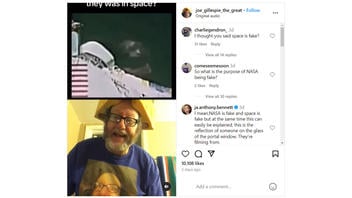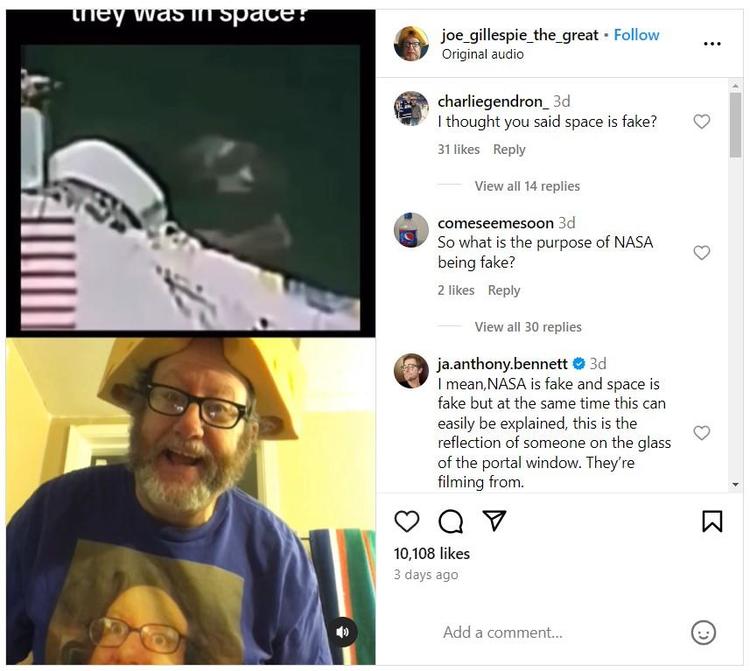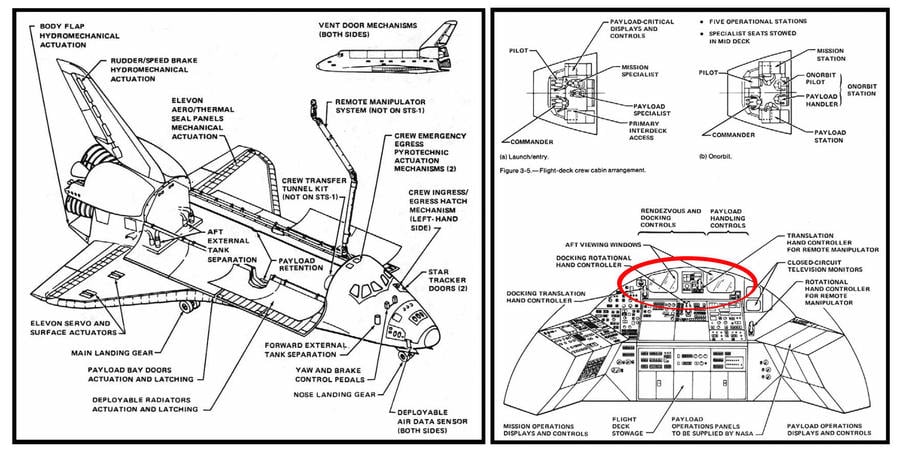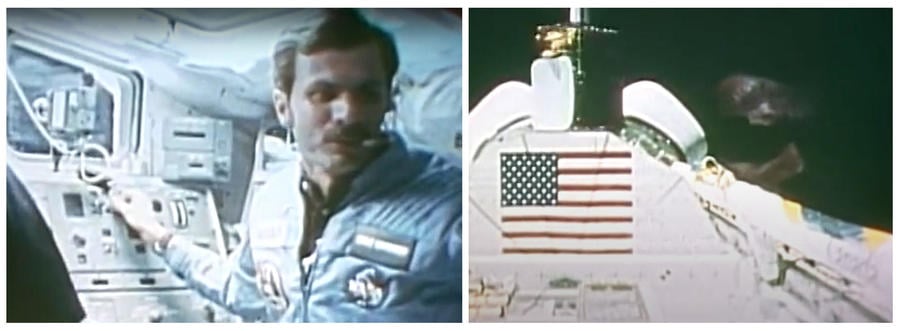
Does footage showing what appears to be a shadowy profile of a man moving behind what looks to be a small model space shuttle prove that this footage and the entire 1983 Challenger mission was faked? No, that's not true: The astronaut was filming from inside Challenger's flight deck looking out over the payload bay through a window. His reflection shows up most clearly in the areas of the frame with the dark background, but in higher-resolution copies of this footage it is possible to also see glimmers of his reflection over the shuttle as well.
The claim appeared in a post (archived here) on Instagram on June 28, 2024. Text on the video clip reads:
they was in space?
This is how the post appeared on Instagram at the time of writing:
(Source: Instagram screenshot taken on Tue Jul 02 18:32:17 2024 UTC)
The narrator of the Instagram video says:
Here we go. See this guy's face pop up behind the space shuttle? Yes ladies and gentleman, that is a man's face moving around behind the space shuttle in outer space. Now I'm going to zoom in where you can get a better look. There you go.
This short clip was taken from about 3:28 minutes into the 15-minute, 57-second-long post-flight presentation given by the crew of Space Shuttle Flight 8. The video covering highlights of the Challenger flight, which launched on August 30, 1983, and landed on September 5, 1983, was posted on the YouTube channel of NASA's Johnson Space Center on August 30, 2018, titled, "STS-8: The First Shuttle Night Launch & Landing."
The Lead Stories composite image below shows two schematic diagrams of the Challenger orbiter (here and here). Below left are the mechanical subsystems shown to illustrate the payload bay with the doors wide open. The diagram below right shows the flight-deck crew cabin arrangement and aft flight-deck configuration. The aft viewing windows over the rendezvous and docking controls and payload handling controls are circled in red.
(Source: Lead Stories composite image made with NASA screenshots taken on Tue Jul 02 21:38:33 2024 UTC)
The orbiter has cockpit windows with a similar configuration to a commercial jet. Mission specialist Guion Stewart Bluford Jr. was seated facing frontward in the footage he is discussing. The narration leading up to this moment in the featured clip is the voice of Bluford, who is describing the footage after the fact. Standing behind him were pilot Daniel Brandenstein, and (pictured below left at 2:42 minutes in) Mission Specialist Dale Gardner.
These astronauts were looking out over the payload bay through small observation windows facing the tail of the challenger. This flight deck configuration is akin to a window on the back of a truck cab. When the payload bay doors are closed, these windows have a view into a closed space, but when the bay doors are open, the windows have a view to outer space and to what is taking place near the tail of the orbiter and in the payload bay.
(Source: Lead Stories composite image of YouTube screenshots taken on Tue Jul 02 22:45:01 2024 UTC)
On this mission an Indian satellite, INSAT-1B, was to be deployed. The footage of this happening (above right), filmed by Gardner from inside the flight deck appears between 3:28 and 3:45 minutes in. This is the same time that the reflection of Gardner on the viewing window appears superimposed over the footage of INSAT-1B deploying. Bluford's narration, starting at 2:26 minutes, says:
One of the objectives of our mission was to deploy the INSAT satellite, and this is the cockpit arrangement associated with deploying the satellite. In this particular view, Dan is actually operating the 16 millimeter camera. Panning the cockpit you can see Dick over there on the left, he's sort of, sort of supervising the operation. There's Dale, he's going to be handling the cameras and the switches. And I'm working from the commander's seat up front sending out commands through a keyboard and talking to the M and satellite through CRT display. You can see, as I said, I was basically our arrangement. Dan sat in the pilot seat during this operation, sort of monitoring the motion of the vehicle making sure that it was steady and that the you know there were very few vibrations of any sort.
Here's a picture of the INSAT actually being deployed from the spacecraft. You can see that the deploy went very smoothly. At the moment of deploy there was a large thump and as I said the spacecraft was deployed very smoothly and there were no vibrations or no precession of the satellite as it left the payload bay.
Gardner is wearing a light-colored aviation headset with the microphone on the left side of his face. At the 3:33-minute mark in the YouTube video it is possible to see faint traces of Gardner's nose and microphone reflection superimposed over light-colored portions of the orbiter in the frame -- and not only over the darker area of outer space. This shows clearly that this footage shows a reflection of an astronaut on glass and not a man moving behind a small-scale model of the Space Shuttle Challenger.
Additional Lead Stories fact checks about NASA hoax conspiracies can be found here.


















